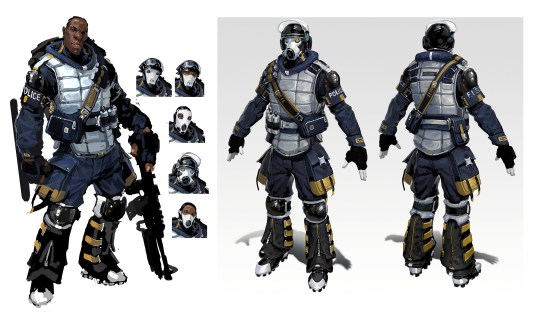One of the things that’s interesting about Brink’s story is that it seems like information on either side, inside the narrative at least, can’t be trusted. Rather than the firm ideological certainty, either side seems like they’re not sure they’re doing the right thing. Why come down on this particular angle for Brink?
I’m tempted to say “Why not?” The choice between Right and Wrong is no choice at all, and dramatically inert. The choice between Right and Right, on the other hand, has much more potential. We deliberately avoided making Brink about Hero Cops versus Evil Terrorists, or Freedom Fighters versus Oppresso-Stormtroopers. Of course, Brink is still a game primarily about running around and shooting, but that doesn’t mean it can’t be anything else.
I always admire games that manage to include and involve real issues without reducing them to a scanty moral, or yet more antagonist-motivation boilerplate. Deus Ex was a notable success: it was the first game I played where I genuinely didn’t know what course to take, not just because I couldn’t divine what the game “wanted” me to do, but because I wasn’t sure in my own mind about the dilemma my character was facing. I’d love it if players felt similarly conflicted about the choices in Brink.
Also, we wanted to avoid the uncanny unanimity that many game worlds are forced into to make things clear to the player and move them forwards; when you go somewhere and everyone tells you the same thing, or you do something and instantly everyone is apprised of it. In the real world, no two people have perfect information or agree entirely about what’s going on, who’s to blame, and what to do about it. Why should Brink’s world be different?
(More on TIME.com: E3 2010: What We’re Looking Forward To)
Some of the required narrative mechanisms are begging to be given some spin. Your faction commander will brief you while we load the map, but that doesn’t mean what he says is necessarily true, or that he’s deliberately misleading you, or even that the characters in that faction’s cinematics agree with him or each other.
Also, conflicts can arise for systemic, not just personal reasons. For example, in Container City the Security receives creditable intel that the Resistance are developing a bio-weapon; they can’t take the chance, they have to go in and grab it. On the other hand, the Resistance players are told it’s a vaccine. What if they’re both being lied to? What if they’re both right?
It seems like one of your jobs is to prevent ludonarrative dissonance–where what the player does doesn’t match up with the narrative drive of the plot. How do you accomplish such a thing?
It’s certainly our job to prevent ourselves from putting things in the game that don’t make sense – its inhabitants can and should disagree, but the gameworld can’t contradict itself. However, we strongly believe that once a player buys a game, they can do what they like.
Brink’s gameplay is like a sandbox – a rule set and a toolkit to let players author their own experiences. The players aren’t on rails, which is why there’s always a reason to go back and play the same map with different tactics, from a different faction, with a different body type, as a different class, with different abilities, and with different weapons that have been customized differently each time.
Our first game, Wolfenstein: Enemy Territory, is nearly eight years old with over half a billion matches played. A big part of that longevity and match count is down to the amazing work of the mod community. But some of it’s down to the inherent unpredictability and insane replayability of the gameplay.


